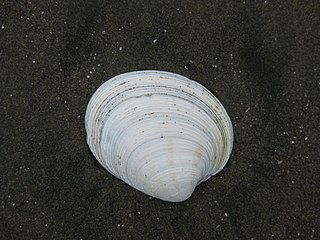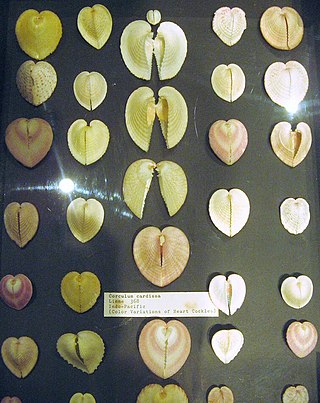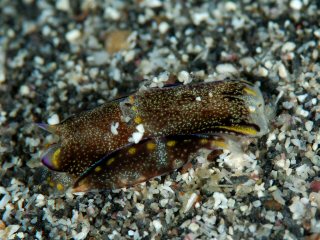
Volutidae, common name volutes, are a taxonomic family of predatory sea snails that range in size from 9 mm to over 500 mm. They are marine gastropod mollusks. Most of the species have no operculum.

Anomalodesmata is an superorder of saltwater clams, marine bivalve molluscs. This grouping was formerly recognised as a taxonomic subclass. It is called a superorder in the current World Register of Marine Species, despite having no orders, to parallel it with sister taxon Imparidentia, which does have orders.

Poromyidae is a family of saltwater clams, marine bivalve molluscs in the order Anomalodesmata. The genus Dilemma, described in 2008, is remarkable for being a predator of copepods, which is very unusual for a sessile mollusc.

Dosina is a genus of marine bivalve molluscs, in the family Veneridae.

Hydroidolina is a subclass of Hydrozoa and makes up 90% of the class. Controversy surrounds who the sister groups of Hydroidolina are, but research has shown that three orders remain consistent as direct relatives: Siphonophorae, Anthoathecata, and Leptothecata.

Corculum is a genus of small saltwater clams, marine bivalve molluscs in the family Cardiidae, the cockles. They maintain Symbiodinium dinoflagellates as symbionts.

Melibe is a genus of sea slugs, nudibranchs, marine gastropod mollusks in the family Tethydidae.
Dilemma inexpectatum is a minute species of deepwater cockle, a marine bivalve mollusc in the family Cardiidae.

Philiopsis is a genus of often colorful, medium-sized sea slugs, marine opisthobranch gastropod mollusks. These are not nudibranchs; instead they are headshield slugs, in the clade Cephalaspidea.
The Budden Canyon Formation is the name of a sedimentary rock formation in California of Cretaceous (Berriasian-Turonian) age.

Phymorhynchus is a genus of sea snails, marine gastropod mollusks in the family Raphitomidae.
Poromyoidea is a superfamily of molluscs. It used to contain only the family Poromyidae, but now it also contains Cetoconchidae Ridewood, 1903, as CetoconchaDall, 1886 was removed from Poromyidae and given its own family, according to the World Register of Marine Species.

Lucina is a genus of saltwater clams, marine bivalve molluscs.

Verticordia is a genus of marine bivalve molluscs in the family Verticordiidae. >
This list of fossil molluscs described in 2021 is a list of new taxa of fossil molluscs that were described during the year 2021, as well as other significant discoveries and events related to molluscan paleontology that occurred in 2021.
Parilimyidae is a family of bivalves belonging to the superorder Anomalodesmata.
This list of fossil molluscs described in 2023 is a list of new taxa of fossil molluscs that were described during the year 2023, as well as other significant discoveries and events related to molluscan paleontology that occurred in 2023.
Grippina is a genus of bivalves in the family Spheniopsidae which currently consists of nine species. It was first described by William Dall in 1912 with G. californica recorded in the eastern Pacific Ocean near California, US. Their habitat spans across the Pacific Ocean, mainly centering around Australia and New Zealand, though G. coronata was found in 2015 off the coast of Rio de Janeiro, Brazil in the western Atlantic Ocean. Bivalves in the genus Grippina are part of the order Anomalodesmata, also known as septibranchs, which are carnivorous clams. They use their inhalant siphons, adapted with sensory papillae to detect motion, to inhale microscopic crustaceans such as ostracods. As sessile, benthic predators, they lie in wait under sand and stick their siphons out into open water to feed. Their shells range in size from about 2–5 millimeters.










